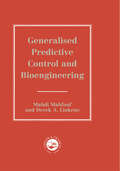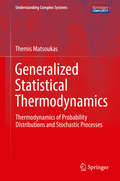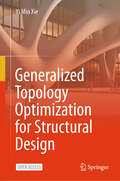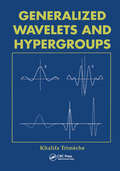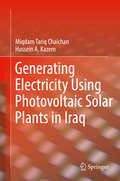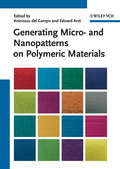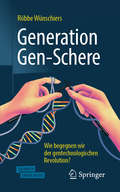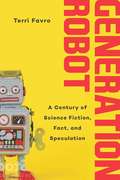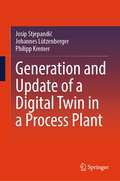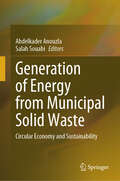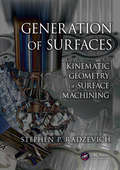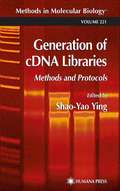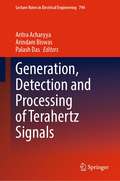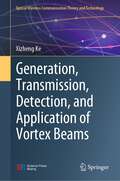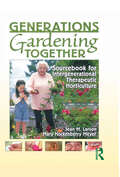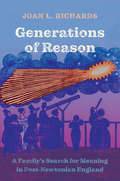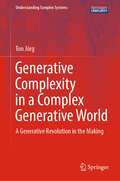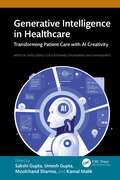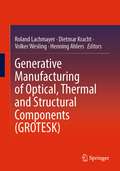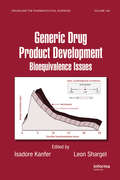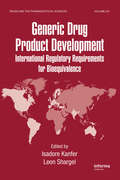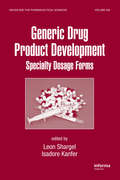- Table View
- List View
Generalized Predictive Control And Bioengineering (Series in Systems and Control)
by M Mahfouf D. A. LinkensPredictive control is a powerful tool in dealing with those processes with large time delays. Generalized Predictive Control GPC is the most popular approach to the subject, and this text discusses the application of GPC starting with the concept of long-range predictive control and its need in medicine particularly automated drug deliveries.; The concept of adaptation is also emphasized with respect to patient-to-patient parameter variations. Subsequent chapters discuss interactions, comparisons and various aspects of GPC. The book concludes by putting into perspective the generic nature of the architecture built around GPC and which provides model-based fault diagnosis with control.
Generalized Statistical Thermodynamics: Thermodynamics of Probability Distributions and Stochastic Processes (Understanding Complex Systems)
by Themis MatsoukasThis book gives the definitive mathematical answer to what thermodynamics really is: a variational calculus applied to probability distributions. Extending Gibbs's notion of ensemble, the Author imagines the ensemble of all possible probability distributions and assigns probabilities to them by selection rules that are fairly general. The calculus of the most probable distribution in the ensemble produces the entire network of mathematical relationships we recognize as thermodynamics. The first part of the book develops the theory for discrete and continuous distributions while the second part applies this thermodynamic calculus to problems in population balance theory and shows how the emergence of a giant component in aggregation, and the shattering transition in fragmentation may be treated as formal phase transitions. While the book is intended as a research monograph, the material is self-contained and the style sufficiently tutorial to be accessible for self-paced study by an advanced graduate student in such fields as physics, chemistry, and engineering.
Generalized Topology Optimization for Structural Design
by Yi Min XieThis book challenges many assumptions commonly used in structural topology optimization. These assumptions include: (1) to find the unique and globally optimal solution—the &‘best&’ design, (2) under prescribed support conditions, (3) for given loading conditions, (4) within a predetermined design domain, and (5) without considering the designer&’s aesthetic preferences. Through a systematic discussion and numerous examples, this book clearly shows that the traditional assumptions are not only unnecessary, but also imposing severe limitations on design freedom and hindering creativity in structural design. The generalized topology optimization framework presented in this book breaks the mold of many conventional thoughts in structural topology optimization. The new framework will enable topology optimization techniques to solve a much wider range of practical problems. This book appeals to researchers and graduate students working in structural design and optimization and is of interest to civil and structural engineers, architects, mechanical engineers, and product designers involved in creating innovative and efficient structures. This book is open access.
Generalized Wavelets and Hypergroups
by Khalifa TrimecheWavelets have recently been enjoying a period of popularity and rapid growth, and the influence of wavelet methods now extends well beyond mathematics into a number of practical fields, including statistics. The theory of hypergroups can be traced back to the turn of the century, and following its formalization in the early 1970s, the area has now
Generating Electricity Using Photovoltaic Solar Plants in Iraq
by Miqdam Tariq Chaichan Hussein A. KazemThis book focuses on solar energy and its applications in Iraq and its neighboring countries. Iraq suffers from electricity shortages and faces many challenges to meet and overcome current and future increases in electrical demand. Although Iraq relies primarily on petroleum as an energy source, many scientists agree that the future of energy efficiency and safety will rely heavily on the implementation of green and renewable energies. This book is aimed at researchers, policymakers, and students and discusses how PV systems can be successfully implemented in order to reduce dependency on fossil fuel resources.Contains case studies and examples to enhance practical application of the technologies presented;Presents actual adopted Iraqi PV projects;Explains the use and application of photovoltaic cells.
Generating Micro- and Nanopatterns on Polymeric Materials
by Eduard Arzt Aránzazu Del CampoNew micro and nanopatterning technologies have been developed in the last years as less costly and more flexible alternatives to phtolithograpic processing. These technologies have not only impacted on recent developments in microelectronics, but also in emerging fields such as disposable biosensors, scaffolds for tissue engineering, non-biofouling coatings, high adherence devices, or photonic structures for the visible spectrum. This handbook presents the current processing methods suitable for the fabrication of micro- and nanostructured surfaces made out of polymeric materials. It covers the steps and materials involved, the resulting structures, and is rounded off by a part on applications. As a result, chemists, material scientists, and physicists gain a critical understanding of this topic at an early stage of its development.
Generation Gen-Schere: Wie begegnen wir der gentechnologischen Revolution?
by Röbbe WünschiersWir erleben derzeit eine neue Dimension der Gentechnik, doch wohin soll die Reise führen? Sollen wir Krankheiten therapieren oder besser genetisch reparieren? Führt die neue Gentechnik verbunden mit der modernen Reproduktionsbiologie zu Designer-Babies? Und: Dürfen wir eine Liberalisierung dieser Techniken als Bürgerwissenschaft (Citizen Science) zulassen?Neue Methoden können das Erbgut präzise verändern – und sie hinterlassen keine Spuren. Diese „Gen(om)chirurgie“ gedeiht auf dem Boden zunehmenden Wissens um die Wirkungsweise der Gene, jenen merkmalsgebenden Bereichen im Genom. Vor allem im Bereich der Züchtung widerstandsfähigerer und ertragreicherer Kulturpflanzen findet dieses Wissen seine praktische Anwendung. Und der Mensch? Der Autor zeigt, dass Genvarianten längst nicht mehr nur mit Krankheiten, sondern auch mit Ernährungsvorlieben oder Intelligenz in Verbindung gesetzt werden. Therapie- und Optimierungsmöglichkeiten liegen nahe beieinander. Welche Wirkung hat die Umwelt auf die Ausprägung des Erbguts? Gene können zu Lebzeiten durch Umwelt, Ernährung oder Erlebtes geprägt und so verändert an die Nachkommen weitergegeben werden. Hat also die Gesellschaft eine neue Form der Langzeitverantwortung für die (epi)genetische Integrität?Der Autor erklärt in diesem anschaulich und verständlich geschriebenen Buch den Stand der Gentechnologie ohne allzu viel Vorwissen vorauszusetzen und lädt zu einem offenen Dialog über dieses ambivalente Thema ein. Machen Sie sich ein eigenes Bild von den faszinierenden und doch auch einschüchternden Möglichkeiten der Gentechnik. Wie stehen Sie dazu? Mithilfe dieses Buches haben Sie die Chance sich eine differenzierte Meinung zu bilden.
Generation Robot: A Century of Science Fiction, Fact, and Speculation
by Terri FavroGeneration Robot covers a century of science fiction, fact and, speculation—from the 1950 publication of Isaac Asimov’s seminal robot masterpiece, I, Robot, to the 2050 Singularity when artificial and human intelligence are predicted to merge. Beginning with a childhood informed by pop-culture robots in movies, in comic books, and on TV in the 1960s to adulthood where the possibilities of self-driving cars and virtual reality are daily conversation, Terri Favro offers a unique perspective on how our relationship with robotics and futuristic technologies has shifted over time. Peppered with pop-culture fun-facts about Superman’s kryptonite, the human-machine relationships in the cult TV show Firefly, and the sexual and moral implications of the film Ex Machina, Generation Robot explores how the techno-triumphs and resulting anxieties of reality bleed into the fantasies of our collective culture.Clever and accessible, Generation Robot isn’t just for the serious, scientific reader—it’s for everyone interested in robotics and technology since their science-fiction origins. By looking back at the future she once imagined, analyzing the plugged-in present, and speculating on what is on the horizon, Terri Favro allows readers the chance to consider what was, what is, and what could be. This is a captivating book that looks at the pop-culture of our society to explain how the world works—now and tomorrow.
Generation and Applications of Extra-Terrestrial Environments on Earth (River Publishers Series In Standardisation Ser.)
by Daniel A. Beysens Jack J. W. A. van LoonThis book has been prepared under the auspice of the European Low Gravity Research Association (ELGRA). The main task of ELGRA is to foster the scientific community in Europe and beyond in conducting gravity and space-related research.This publication is dedicated to the science community, and especially to the next generation of scientists and engineers interested in space research and in the means to use Earth to reproduce the space environment. ELGRA provides a comprehensive description of space conditions and the means that have been developed on Earth to perform space environmental and (micro-) gravity related research. .The book covers ground-based research instruments and environments for both life and physical sciences research. It discusses the opportunities and limitations of protocols and instruments to compensate gravity or simulate microgravity, such as clinostats, random positioning machines, levitating magnets, electric fields, vibrations, tail suspension or head down tilt, as well as centrifuges for hyper-g studies. Other space environmental conditions are addressed too, like cosmic radiation or Mars atmospheric and soil properties to be replicated and simulated on Earth. Future long duration of manned missions, personal well-being and crew interaction are major issues dealt with.
Generation and Parametric Amplification of Few‐Cycle Light Pulses at Relativistic Intensities (Springer Theses)
by Alexander KesselThis book reports on the development of a pioneering light source architecture of the so-called Petawatt Field Synthesizer (PFS) system, which is based on short-pulse pumped, optical parametric chirped pulse amplification (OPCPA), driven by a homemade, 1-ps diode-pumped Yb:YAG. At a few-cycle pulse duration of the amplified pulses, this architecture yields record levels of peak power and temporal contrast, the latter boasting a 100-times faster rise time from the noise level to peak intensity of the pulse compared to conventional laser systems. This allows investigation of the true laser–solid interaction without premature plasma expansion and without lossy pulse cleaning by e.g. plasma mirrors. The book describes several concepts for the generation of broadband, high-energy and high-contrast seed pulses, as well as the OPCPA development, few-cycle pulse compression and contrast characterization in a concise and insightful manner. The theory chapter serves as an excellent and accessible primer on OPCPA and other nonlinear interactions, while the experimental parts provide an excellent description of the challenges of developing such a novel architecture and some of the innovative solutions to overcome them.
Generation and Update of a Digital Twin in a Process Plant
by Josip Stjepandić Johannes Lützenberger Philipp KremerThis book covers the most important subjects of digital twin in a process plant, including foundations, methods, achievements, and applications in a brownfield environment. Besides offering a variety of applications and procedural variants from research and industrial practice, this book also provides a comprehensive insight into holistic plant planning. It also discusses the challenges that currently exist in different application areas. This book would be of interest to industry professionals and researchers in industrial and manufacturing engineering.
Generation of Energy from Municipal Solid Waste: Circular Economy and Sustainability
by Salah Souabi Abdelkader AnouzlaThis book endeavors to critically assess and analyze the latent energy potential inherent within waste materials, thereby reframing the conventional perception of garbage from being solely a detrimental source of environmental pollution to being recognized as a viable and sustainable energy source. Furthermore, this book provides an extensive and meticulously curated database that serves as an invaluable resource to guide stakeholders in selecting the most appropriate and effective methodologies for waste disposal, whilst facilitating the generation of renewable energy that can significantly contribute to energy sustainability. In undertaking this comprehensive evaluation, the book highlights the transformative possibilities of waste management practices. It underscores the broader implications for environmental conservation and the advancement of renewable energy technologies in contemporary society. The text comprises 17 chapters on waste management with clean energy generation (heat, CH4, H2, diesel, petrol, methanol, ethanol, etc.) that experts in the field have suggested. Energy from trash may be recovered, which results in a decrease in greenhouse gas emissions and the creation of new recovery technologies. Lowering environmental pollution is an intelligent approach to ensure national energy security and combat the trend toward global warming.
Generation of Surfaces: Kinematic Geometry of Surface Machining
by Stephen P. RadzevichA commonly used practice in industry is the machining of sculptured part surfaces on a multiaxis numerical control (NC) machine. While this practice is vital, it is also a costly aspect of the surface generation process. After investing more than 40 years of research into the theory of part surface generation, the author of Generation of Surfaces:
Generation of cDNA Libraries
by Shao-Yao YingExpert researchers and inventors in the field describe their own proven techniques for generating cDNA/mRNA libraries to identify the functions of specific decoded gene sequences. A wide variety of techniques is presented for enhancing the generation of complete and full-length libraries, and for confirming the quality of the cDNAs generated. Among the applications detailed are electrophoresis, Northern blotting, single cell microarray analysis, subtractive hybridization, subtractive cloning, gene cloning, and peptide library generation.
Generation, Detection and Processing of Terahertz Signals (Lecture Notes in Electrical Engineering #794)
by Arindam Biswas Aritra Acharyya Palash DasThis book contains detailed descriptions and associated discussions regarding different generation, detection and signal processing techniques for the electrical and optical signals within the THz frequency spectrum (0.3–10 THz). It includes detailed reviews of some recently developed electronic and photonic devices for generating and detecting THz waves, potential materials for implementing THz passive circuits, some newly developed systems and methods associated with THz wireless communication, THz antennas and some cutting-edge techniques associated with the THz signal and image processing. The book especially focuses on the recent advancements and several research issues related to THz sources, detectors and THz signal and image processing techniques; it also discusses theoretical, experimental, established and validated empirical works on these topics. The book caters to a very wide range of readers from basic science to technological experts as well as students.
Generation, Transmission, Detection, and Application of Vortex Beams (Optical Wireless Communication Theory and Technology)
by Xizheng KeThis book focuses on the key technologies supporting orbital-angular-momentum multiplexing communication: generation, transmission, detection, and application of vortex beams. A series of methods for generating vortex beams are described and compared in detail. Laguerre-Gaussian and Bessel-Gaussian beams are taken as examples to introduce the transport properties of vortex beams in atmospheric turbulence. The authors show that superposition of vortex beam state, interference, diffraction, and grating can realize the detection of the topological charge of vortex beams. The authors also introduce the application of vortex beams in optical communication and the transmission characteristics of partially coherent vortex beams in atmospheric turbulence. Finally, the authors describe vortex beam information exchange and channel reconstruction.
Generations Gardening Together: Sourcebook for Intergenerational Therapeutic Horticulture
by Jean M. Larson Mary MeyerBring a Sensory Garden to life in a structured therapeutic horticulture program!Intergenerational gardening programs bring the generations together. This book presents a tested, hands-on, easy-to-use activity plan that benefits the development of relationships between adults over 70 and school-age children. It shows how to limit frustration for both groups, how to plan activities that are functional and non-contrived, and how to assure that the interaction between elders and children is rewarding and pleasant for both. The activities rely on inexpensive, readily available tools and resources available throughout the growing season.While other books have discussed designing a Sensory Garden for people with disabilities, Generations Gardening Together applies the Sensory Garden design to a specific population, with a focus on the human senses that are stimulated by the garden. This unique sourcebook shows you, step-by-step, how a Sensory Garden can come alive in a structured therapeutic horticulture program. Generations Gardening Together shows how to create a Sensory Garden that will stimulate young and old gardeners alike. It outlines a six-week program curriculum that has been used and developed over ten years to use gardening as a program to bring generations together. You’ll learn therapeutic techniques that benefit elders by promoting self-esteem, creating feelings of pride, competence, and satisfactionboth from creating a garden and through passing on their knowledge and wisdom to the younger generation, inspiring them to use both their long-term and short-term memory skills, increasing physical stimulation, and providing the comfort of familiar plants and their aromas, which can trigger memories of people, places, and vocations. The activities in the book also benefit children through the establishment of a safe environment where people of all ages, backgrounds, and abilities can come togetheran ideal social situation in which youth can seek the wisdom of elders. Children learn important lessons about accountability, nurturing, and responsibility, for working in a garden teaches youth about life, death, hope, patience, and beauty.Each activity session described in Generations Gardening Together includes the following information: titledescribes the content of the program general statement of purposeidentifies the intent of the program goal(s)outlines the expected outcome(s) of the activity program proceduresprovides a detailed description of each step and the order of the program’s activities evaluationincludes what and how therapeutic program goals are to be measured and recorded materials and equipmentidentifies all the necessary equipment and supplies needed to facilitate the program activity This important resource shows how to provide appropriate (separate) orientation to seniors and children, what to emphasize and what to avoid in creating a program in your community, how to create garden themes that reflect the interests of the participants (ethnic foods, bird and butterfly gardens, planting to attract wildlife, etc.), how to decide what activities are appropriate for the developmental level of the participants, and much more. Generations Gardening Together is an essential resource for therapeutic recreation specialists, occupational therapists, therapeutic horticulture professionals, activity coordinators, master gardeners, and anyone working in an environment where elders and children come together.
Generations of Reason: A Family's Search for Meaning in Post-Newtonian England
by Joan L. RichardsAn intimate, accessible history of British intellectual development across the eighteenth and nineteenth centuries, through the story of one family This book recounts the story of three Cambridge-educated Englishmen and the women with whom they chose to share their commitment to reason in all parts of their lives. The reason this family embraced was an essentially human power with the potential to generate true insight into all aspects of the world. In exploring the ways reason permeated three generations of English experience, this book casts new light on key developments in English cultural and political history, from the religious conformism of the eighteenth century through the Napoleonic era into the Industrial Revolution and prosperity of the Victorian age. At the same time, it restores the rich world of the essentially meditative, rational sciences of theology, astronomy, mathematics, and logic to their proper place in the English intellectual landscape. Following the development of their views over the course of an eventful one hundred years of English history illuminates the fine structure of ways reason still operates in our world.
Generative AI for a Net-Zero Economy: Managing Climate Change and Business Innovation in the Digital Era
by Subhankar Das Subhra R. Mondal Lukas VartiakThis book covers the technological aspects of Generative AI, its applications in achieving a net-zero carbon economy, the challenges of climate change, and the economic and management implications of these transitions. The book explores the transformative potential of Generative AI in driving the transition to a net-zero economy. It examines how this cutting-edge technology is revolutionizing climate change mitigation strategies and reshaping business models in the digital age. The book offers a comprehensive guide to leveraging AI for sustainable innovation through case studies, expert insights, and forward-thinking analysis. It addresses the challenges and opportunities in integrating AI into climate action plans, economic policies, and corporate strategies. Essential reading for policymakers, business leaders, and technologists, this book provides a roadmap for harnessing Generative AI to create a sustainable, prosperous future encompassing several key elements that align with the United Nations Sustainable Development Goals, in particular SDG 13: Climate Action.
Generative Complexity in a Complex Generative World: A Generative Revolution in the Making (Understanding Complex Systems)
by Ton JörgThis book introduces a refreshing approach to twenty-first-century scientific approach in an age, which is also known as the Century of Complexity. It deals with the deep problem of complexity, being operative from the bottom-up. The current lack of understanding of complexity has led scholars into the so-called embarrassment of complexity. A long overdue paradigm shift is necessary to address complexity as generative complexity and brings readers to the edge of a scientific revolution: that is, a generative revolution in the Century of Complexity. The book offers a radical shift of paradigm from the paradigm of simplifying into the new generative paradigm of complexifying about processes that develop from the bottom-up. The book links complex generative reality with a corresponding radical new generative nature of order and explores new fronts in science. This book explores innovative concepts of interaction, of causality, of the unit of study, and of reality itself and enables readers to see complexity as generative, emergent complexity as being operative from the bottom-up. The book discusses and suggests solutions for the problem of complexity in this Century of Complexity. The author provides a new understanding of complexity based on a generative flux of forces and relations. The book aims to bring about a fundamental and foundational change in how we view and ‘do’ science for an interdisciplinary audience of academics ranging from social science and humanities to economy and biology.
Generative Intelligence in Healthcare: Transforming Patient Care with AI Creativity (Artificial Intelligence for Sustainable Engineering and Management)
by Umesh Gupta Moolchand Sharma Sakshi Gupta Kamal MalikThis book explores the intersection of artificial intelligence and healthcare with a focus on generative intelligence. The book will introduce the concept of generative intelligence and its transformative potential in patient care, showcasing applications that go beyond conventional AI approaches.Generative Intelligence in Healthcare: Transforming Patient Care with AI Creativity delves into the use of generative models for personalized medicine, data analytics, and predictive modelling, providing real-world examples of how AI creativity can revolutionize treatment strategies and diagnostic processes. It focuses on the origin and basics of generative AI, generative AI models, and possible areas in healthcare where generative AI can work. It discusses how generative AI model will help healthcare providers automatically generate prescriptions, discharge summaries, and patient conditions. The unique strength of this book lies in its comprehensive examination of ethical considerations and regulatory frameworks, ensuring a responsible and transparent integration of generative intelligence in healthcare. By addressing current challenges and envisioning future directions, this book serves as a valuable resource for healthcare professionals, researchers, and policymakers seeking to harness the full potential of AI creativity to enhance patient outcomes.The book is written for graduate students, researchers, and professionals in biomedical engineering, electrical engineering, signal process engineering, biomedical imaging, and computer science.
Generative Manufacturing of Optical, Thermal and Structural Components (GROTESK)
by Roland Lachmayer Dietmar Kracht Volker Wesling Henning AhlersThe book describes and explains the results of the collaborative project Generative Manufacturing of Optical, Thermal and Structural Components over the last three years. The overall goal is the development of a system concept based on generative manufacturing for integrated optical and optomechanical systems. Different developed generative manufacturing processes for glass and specially designed metal powders have been implemented in a single fabrication set up enabling multi-material manufacturing of optical components and systems. The main focus of the project is split into several topics: simulation, design, material engineering, process engineering, post-processing and component evaluation. The simulation of the glass printing process will be structured iteratively with a comparison of the experimental results in order to be able to finally make a prediction of the necessary parameter sizes for defined components. A metal material with similar thermal conductivity and thermal expansion properties to glass or laser-active crystals has been developed iteratively over the course of the project to enable direct printing onto these materials. In order to demonstrate the potential of generatively manufactured optomechanics for function-integrated systems, the optomechanical components required for a solid-state laser system are manufactured in a polymer-based 3D printing process and their properties are characterized. All these individual projects of the overall network are combined in the system concept.
Generic Drug Product Development: Bioequivalence Issues
by Isadore Kanfer Leon ShargelThe assessment of bioequivalence is an important process whereby the bioavailability of a generic drug product is compared with its brand-name counterpart. Generic pharmaceutical products must be approved as therapeutic equivalents to the brand name alternative in order to be interchangeable. The demonstration of bioequivalence is an important comp
Generic Drug Product Development: International Regulatory Requirements for Bioequivalence
by Isadore Kanfer Leon ShargelDue to a worldwide need for lower cost drug therapy, use of generic and multi-source drug products have been increasing. To meet international patent and trade agreements, the development and sale of these products must conform to national and international laws, and generic products must prove that they are of the same quality and are therapeutica
Generic Drug Product Development: Specialty Dosage Forms
by Isadore Kanfer Leon ShargelGeneric Drug Product Development: Specialty Dosage Forms explores the issues related to providing evidence of pharmaceutical equivalence and bioequivalence for specialty drug products. It describes various scientific approaches and regulatory requirements for manufacturers who need to demonstrate the therapeutic equivalence of generic specialty dru
